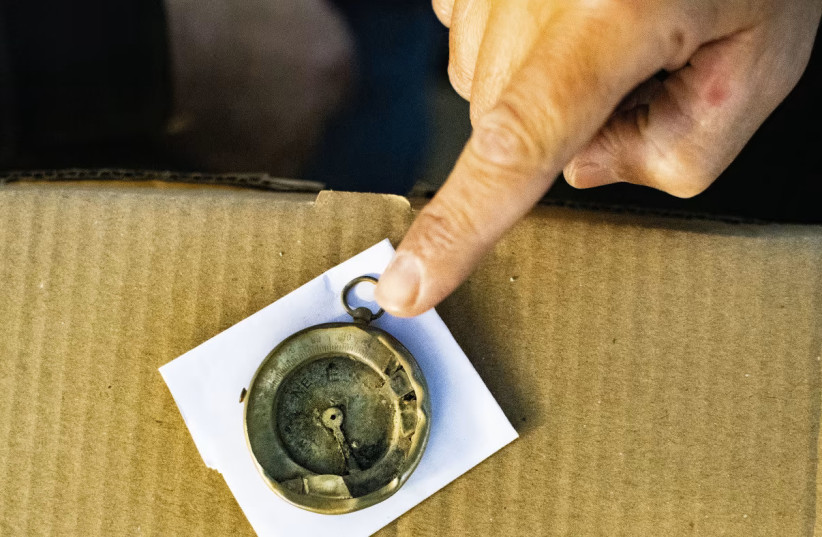A compass belonging to one of the soldiers of the Mountain Platoon (the "Lamed Heh" or "35") was discovered at the top of Battle Hill in the Yehuda Lowlands, next to Bren machine gun shells.
According to researchers Dr. Rafi Lewis from Ashkelon Academic College and Haifa University and Eyal Marco from the Antiquities Authority, the compass belonged to the commander of the division, Dani Mass, or to one of the two scouts who fought in force - Yitzhak Halevi or Yitzhak Zevuloni.
The "Lamed Heh" case is one of the most difficult cases of the 1948 war. Even after more than 75 years since the battle took place, in which all 35 fighters who were on their way to help the besieged Gush Etzion were killed, the event still occupies an important place in the Hebrew and Zionist ethos.
The research findings will be published at the beginning of May in the scientific journal Studies of the Land of Judah of the Israeli Antiquities Authority and Kfar Etzion Field School, produced in cooperation with the KKL-JNF, Bar-Ilan University, the Nature and Parks Authority, the Jesselson Foundation and Mizrah R&D. The journal is produced as part of the "Studies of the Land of Yehuda" conference which will be held on May 8 (Lag Ba'Omer).
For the past two years, Lewis and Marco have been conducting a unique archaeological study on the Lamed Heh Battle Hill. Dr. Lewis and Marko met for the first time during reserve service in the Eitan unit for locating missing persons in the IDF. There, they use archaeological methods to search for soldiers whose burial place is unknown.

The research, which uses archaeological methods to research events that occurred in the recent past, examines the Lamed Heh hill from the archaeological and environmental angle, and collects - for the first time, in an orderly and systematic way - evidence that remains from the battlefield to this day.
Researchers rushed to gather evidence before it disappears
This evidence joins the few findings collected from the area by the Sde Kfar Etzion High School, and the testimonies collected in the past from the Arab fighters and the British officer who coordinated the collection of the bodies of the fighters and carried out an investigation of the Arab fighters in the field. Not a single fighter from the Israeli side of the platoon survived to tell the story.
"We saw that the material evidence from the battle was disappearing," said Marco and Dr. Lewis. "The objects are weathering in the field, and travelers are collecting souvenirs, and we felt that if we don't do it now, in a few years we won't have the opportunity to recreate the battlefield. With the help of colleagues, family members and reserve friends, we set off."
On one of the days of research, the researchers found at the top of the battle hill, behind a rock that was apparently used as a shelter for one of the fighters, a number of Bren machine gun shells and a brass compass, which has a dial locking mechanism.
In-depth and international research shows that the compass - of a simple type, which did not bear the manufacturer's name, was created during the first third of the 20th century. Forensic research done at the Israel Police laboratories showed that the glass of the compass was shattered as a result of a bullet that pierced the frame of the compass, scratching and shattering its glass.
"At this point, it is impossible to associate the compass with a specific fighter, but it is likely that it belonged to one of three - the platoon commander Dani Mass, or one of the two rangers who fought with the force - Yitzhak Halevi or Yitzhak Zevuloni," said Lewis. "Certain identification of the original owner of the compass is not possible at this stage, but we have hope that in the future archival material will be discovered that will make this possible."
Marco stated that "The fact that the compass corresponds to the period in which the battle took place, and the fact that the compass was found to have been hit by a projectile, reinforces the assumption that it was used in the Battle of the Lamed He, and also shows that a commanding figure - or at least a leading figure, was present at the scene of the last battle."
On a personal note, Lewis and Marko added that "This study is a kind of punch in the stomach. It is unlike any archaeological research we have done. Even if the events we investigated from the distant past included evidence of destruction and severe acts of violence, the research at the battle hill is different: indeed, 75 years have passed since the fall of the Lamed He, but here, there are faces and names. There is an almost personal acquaintance with each of the characters. You wonder what happened to the fighters, or whether the compass - bearing the marks of a bullet, pierced the heart of whoever held it in their pocket or hand. You perform work as scientifically as possible, but it is very difficult to detach yourself from the emotional aspect."
